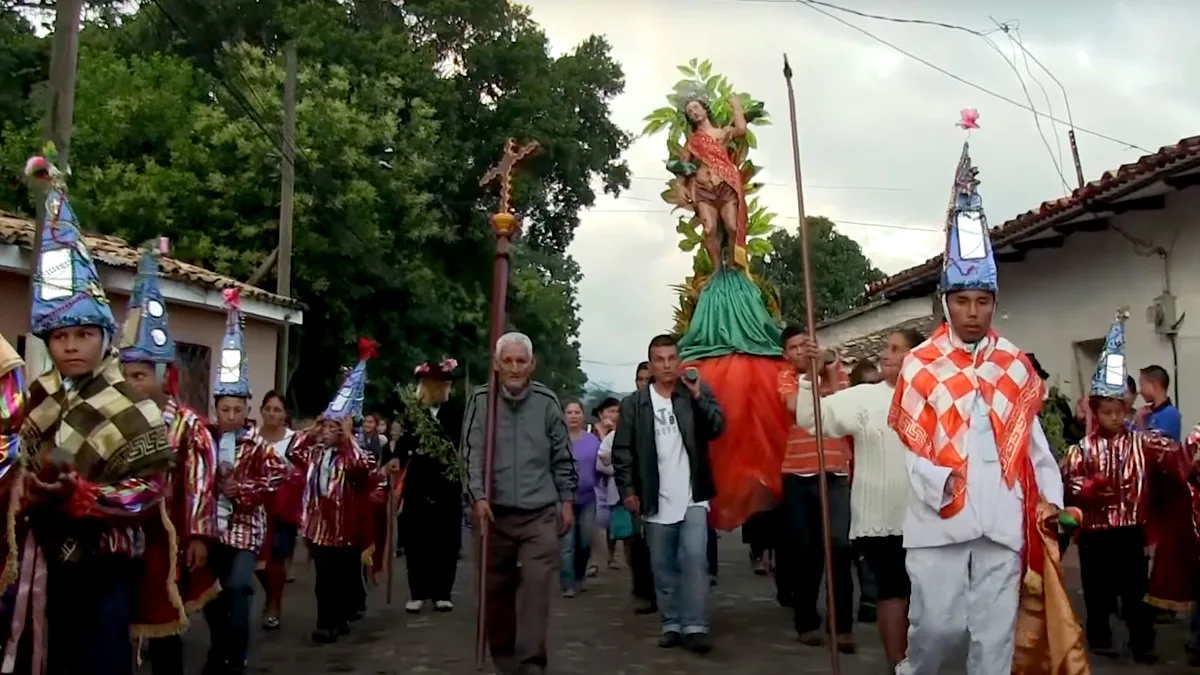Celebration of El Guancasco in Honduras
The wars and disputes between Lencas communities in pre-Columbian and colonial times were part of the quest for hegemony among chiefs and lordships. The only way to settle their differences was through an agreement represented in a dance called El Guancasco.
El Guancasco is a dance between villages as a symbol of peace and encounter between two communities, performed as a fraternal way to promote communion. The ritual, carried out with ceremonial masks in the town square, accompanied by flutes, drums, shouts, offers food and drink to the residents of the community where El Guancasco takes place.
El Guancasco bears similarities to the representations of the Moors and Christians in Spain.

Lenca Tradition
After the colonial era, the Lencas enriched El Guancasco with religion. In addition to being a peace agreement between communities, it became a thanksgiving to God and a celebration of patrons among the involved villages.
The religious, social, and political syncretism of El Guancasco has endured over time, and in the 21st century, this practice remains active. Villages like Gracias and Mexicapa in the department of Lempira have promoted this custom, and every year between December and January, solidarity and brotherhood are part of the encounter between both communities.
Salvador E. Echigoyen, head of information at the Honduran Institute of Tourism, commented that El Guancasco creates a space for exchange and communication between two communities, reaffirming the bonds of brotherhood between those villages year after year.
Learn more about the Lenca ethnic group
Composition of El Guancasco
Initially, the mayordomo (steward) of one of the villages extends an invitation to celebrate a festival. Then, a banquet is held where they eat stew (pork with vegetables). Afterwards, they bring a delicacy with bread and chocolate, and finally, the honored village performs a dance (Guancasco) as a gesture of gratitude.
El Guancasco consists of a group of dancers, approximately 21 people, arranged in two rows of 7 people each, called «bailantes» (dancers), 4 «negros» (black figures), one alcaldesa (mayoress), and one mayordomo (steward).
The act lasts about 25 minutes, during which they express gratitude to the saint and patron for the harvest and the good relations between the involved villages.
Attire used in El Guancasco
- Monarca: Wears white pants, a white shirt, and a red sash (symbolizing hierarchy and power).
- Bailantes: They dress in typical Western attire (ochre-striped shirt) adorned with a crown, mirrors, and necklaces. The crown signifies leadership.
- Negros: They dress in black jackets and black pants.
Parts of El Guancasco:
- Alabado (Celebration with singing to the patron or saint)
- Parejas (Perform a ritual representing the two communities)
- Trapiche or cadena (Representation of unity)
- Zip zap with the group
- El polvo (Throwing dust at the negros, symbolizing forgiveness)
Communities where El Guancasco takes place
January
- Guancasco between Ilama and Gualala (Gualala, Santa Bárbara)
- Guancasco between Gracias and Mexicapa (Gracias, Lempira)
- Guancasco between Erandique and its villages
- Guancasco between Ojojona-Lepaterique (Francisco Morazán)
- Guancasco between Ilama, Gualala-Chinda (Santa Bárbara)
February
- Guancasco between Lejamaní and Comayagüela (Francisco Morazán)
- Guancasco between La Campa, Belén (Garrobo Dance) (Lempira)
April (Holy Week)
- Friday of Los Dolores: Guancasco between Taulabé and Jaitique (Comayagua)
June
- Guancasco between the Villa of San Antonio and Yarumela (Villa de San Antonio, Comayagua)
July
- Guancasco between Lepaterique and Ojojona (Francisco Morazán)
October
- Guancasco between Texiguat and Liure (El Paraíso)
December
- Guancasco between Gracias and Mexicapa
- Guancasco between Yamaranguila and San Francisco de Opalaca (Intibucá)
- Guancasco between Lejamaní and La Cuesta (Comayagua)


